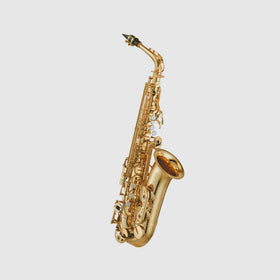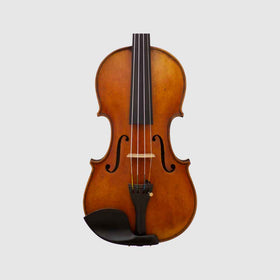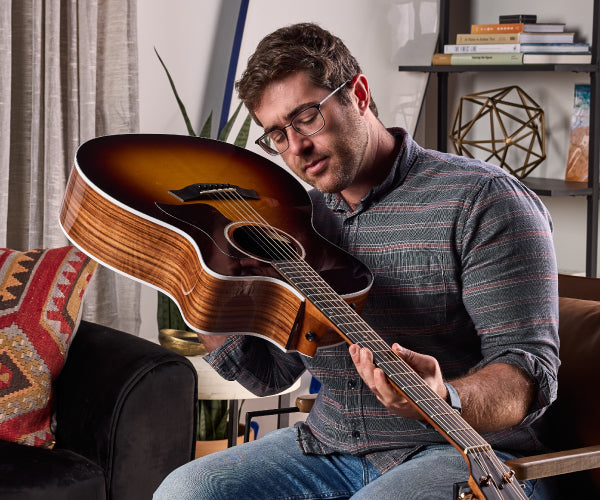Taylor Guitars
Founded in 1974, by Bob Taylor & Kurt Listug. Taylor's serial numbers with 9, 10, or 11 digits are decoded differently.
10-Digit Serial Numbers (2009 - Present Day)
Taylor's current 10-digit serial numbering format that started in November of 2009 identifies where the guitar was built, the start date, and the assigned number of the guitar on that day's production schedule. For example, the serial number for the first guitar built in the El Cajon (USA) factory on July 6, 2014 is 1107064001. See the explanation below:
1107064001 - The first digit indicates where it was made. (1 = El Cajon, California, USA; 2 = Tecate, Baja California, Mexico)
1107064001 - The 2nd & 7th digits indicate the two-digit year - '14 (2014)
1107064001 - The 3rd & 4th digits indicate the two-digit month - 07 (July)
1107064001 5th & 6th digits indicate the day - 06 (the 6th)
1107064001 The last three numbers indicate the guitar's position in that day's production sequence.
9-Digit Serial Numbers (1993 - 1999)
From 1993 until the end of 1999, each Taylor guitar featured a nine-digit serial number that pinpoints when work began on that guitar, along with its series and production position. See the explanation for serial number 980311301 below:
980311301 First two digits indicate the year - 98 (1998)
980311301 3rd & 4th digits indicate the two-digit month - 03 (March)
980311301 5th & 6th digit indicate the day - 11 (the 11th)
980311301 7th digit is a series code number - 0 for 300 or 400 Series, 1 for 500 through Presentation Series, 2 for 200 Series, 3 for a Baby or Big Baby (through 2002), 4 for a Big Baby (2003-2009), 5 for a T5, 7 for Nylon Series, 8 for 100 Series, and 9 for SolidBody Series. This example is number 3, a Baby.
980311301 Last two digits indicate the guitar's position in that day's production sequence.
11-Digit Serial Numbers (2000 - 2009)
January 2000 - October 2009, the serial number expanded from 9 to 11 digits to accommodate the four-digit year designation. Other than the first four digits noting the year, it's decoded the same as the 9-digit serial numbers. See the explanation for serial number 20070311301 below:
20070311301 First four digits indicate the year - 2007
20070311301 5th & 6th digits indicate the two-digit month - 03 (March)
20070311301 7th & 8th digits indicate the day - 11 (the 11th)
20070311301 - The 9th digit is a series code number - 0 for 300 or 400 Series, 1 for 500 through Presentation Series, 2 for 200 Series, 3 for a Baby or Big Baby (through 2002), 4 for a Big Baby (2003-2009), 5 for T5, 6 for T3, 7 for Nylon Series, 8 for 100 Series, and 9 for SolidBody Series. This example is number 3, a Baby.
20070311301 Last two digits indicate the guitar's position in that day's production sequence.
For models older than 1993
| Serial Numbers | Year |
|---|---|
| [No Serial Numbers] | 1974 |
| 00109 & 10109 to 10146 | 1975 |
| 20147 to 20315 | 1976 |
| 20316 to 450 | 1977 |
Note: Mid-1977 Taylor switched from the 5-digit to a 3-digit serial number.
| Serial Numbers | Year |
|---|---|
| 451 to 900 | 1978 |
| 901 to 1300 | 1979 |
| 1301 to 1400 | 1980 |
| 1401 to 1670 | 1981 |
| 1671 to 1951 | 1982 |
| 1952 to 2445 | 1983 |
| 2446 to 3206 | 1984 |
| 3207 to 3888 | 1985 |
| 3889 to 4778 | 1986 |
| 4779 to 5981 | 1987 |
| 5982 to 7831 | 1988 |
| 7832 to 10070 | 1989 |
| 10071 to 12497 | 1990 |
| 12498 to 15249 | 1991 |
| 15250 to 17947 | 1992 |
4-Digit Serial Numbers
When the 410 was introduced in 1991 it was given a unique serial numbering. The serial number has a "4-" plus four more digits like this: 4-1068. This system was only used for two years, with 0001-1121 covering 1991 and 1122-3152 covering 1992.
Fender
Founded in 1946, by Clarence Leonidas "Leo" Fender.
Made in Mexico
Fender began producing instruments in its Ensenada, Mexico, factory in 1990. Instruments made between 1990 and 2000 carry “MN” prefix serial numbers, with the “M” designating Mexico and the “N” designating the 1990s.
The numbers for each year typically overlap, as there is always a transitional period between successive years and as necks that are made and serial numbered late in any given year are used on instruments assembled in the early months of the following year.
At the end of 1999, the serial numbers transitioned from an “MN” prefix to an “MZ” prefix with the “M” designating Mexico and the “Z” designating the 2000s.
A new serial-numbering scheme was adopted toward the end of 2009 using the number “10” as a prefix, followed by a space, followed by seven digits. The “10” prefix was designed to identify the first year of the second decade of the new millennium, and while it appears on the instrument decals, it was not captured in Fender’s operating system. Only the seven-digit suffixes were actually entered into the database. These serial numbers did not identify the country of origin in the body of the number. Instead, the instrument’s country of origin appears on the decal on the back of the headstock, near the serial number.
This new numbering scheme was short-lived and was replaced only a few months later by an improved scheme that identifies an instrument’s country of origin and year of manufacture in the body of the serial number.
This new scheme uses the letters “MX” as a prefix to designate an instrument made in Mexico, followed by an eight-digit number. The first two digits of the number identify the year of manufacture, (10 for 2010, 11 for 2011, etc.). The following six digits are the unit identifier, although it should be noted that these final six numbers are not sequential and do not provide any other identification information about the instrument. This new scheme is now used on the majority of Fender instruments made in Mexico, with certain exceptions.
Exceptions for Instruments 'Made in Mexico'
The Jim Root Telecaster, James Burton Standard Telecaster, Buddy Guy Stratocaster (polka dot model), Robert Cray Stratocaster and Jimmie Vaughan Stratocaster use an “MSN” serial number prefix. Note: in October 2010, some artist models switched to the new “MX10” numbering scheme.
The Ritchie Blackmore Stratocaster and Duff McKagan P Bass use an “MSZ” serial number prefix.
The Reggie Hamilton and Frank Bello Jazz basses used an “MX” serial number prefix before the 2010 change.
California Series electric guitars and basses from 1997 and 1998 use an “AMXN” prefix and share U.S./Mexico origin.
For Fender Instruments 'Made in Japan'
Records on early Japanese-made Fender instruments are not complete and are therefore not completely definitive for dating purposes. As always, serial numbers should only be used as a guide for dating and should be used in combination with known age-related specifications to help identify the production year of an instrument.
In 1997, Fender transitioned to a serial number decal that included the words “Crafted in Japan” above the serial number.
2007 was another transitional year for Japanese-made Fender instruments, with the return to the “Made in Japan” country-of-origin identifier on the serial number decal. This was a running change, and both “Made in Japan” and “Crafted in Japan” decals appear on instruments from 2007 and 2008.
Note: A new Japanese vendor was enlisted in 2010 to help meet demand for the Geddy Lee and Marcus Miller Jazz Bass models. These two basses and the other instruments listed below that were supplied by this factory continued to use “Made in Japan T + 6 digits” designation through 2011:
In 2012, Fender has transitioned the numbering scheme again with the new serial number starting with “JD” followed by an eight-digit number with “Made in Japan” decals.




